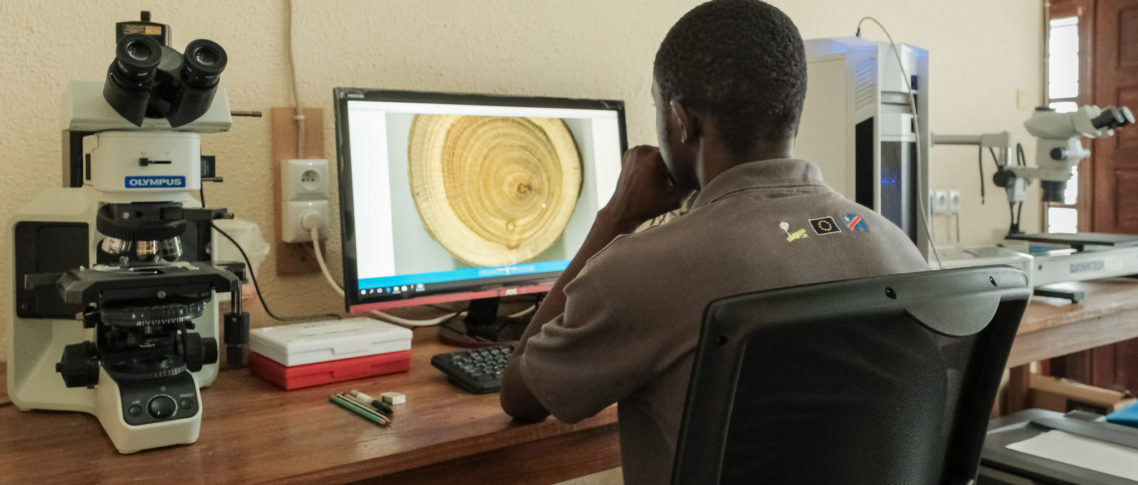Tropical forests are magical places. Inside the bustling canopy, huge buttress trees and evergreen plants make a bountiful home for birds, animals and insects, all together completing some of Earth’s most rich and diverse ecosystems. But they currently face unprecedented stress.
As well as battling land degradation and deforestation- rising temperatures, increasingly intense rainfall, and extended periods of drought caused by climate change are already altering how trees behave. While some species have shown capacity to keep up with changing conditions by growing and dispersing their seeds more quickly, others seemingly lack the pace required for their survival.
For Chadrack Kafuti, a 26-year-old forest engineer from the Democratic Republic of the Congo (DRC), this dreary scenario calls for more research on what’s behind trees’ adaptability to climate change. This is why he has decided to become a scholar on wood biology, determined to help tropical trees survive global warming and overexploitation. “To ensure that our forests continue to thrive for the generations to come, we need to first understand the functioning of trees”, he explains.
Some trees can adjust their water use depending on water availability
HOW CAN TREES ADAPT TO CLIMATE CHANGE?
The key to understanding tropical tree species’ adaptation mechanisms is to closely examine their leaves and wood, Kafuti points out. The relationship between their traits, such as shape, structure, chemical properties and functioning, renders species more or less vulnerable to water stress and unstable weather conditions.
In a collaborative project that studied tropical trees’ capacity to respond to environmental changes, Kafuti’s team observed the functional tradeoffs between wood and leaves. “We found that there is coordination between the wood, responsible for water supply, and the leaves, responsible for water use, to fight for survival. Some trees can adjust their water use depending on water availability.”
Kafuti and his colleagues measured wood and leaf traits of branches from different heights of the tree crown. They found that the ones at the top had better developed this coordination mechanism. “At the top of the crown the environment is more extreme and variable, so those twigs have become more water-use efficient,” he says, before concluding that though a single species might be able to cope with climate change, not all of its trees will be “able to adapt so efficiently”.
SAVING AN ENDANGERED TREE SPECIES
Kafuti dedicates himself to study Afrormosia (Pericopsis elata), a tropical tree species scattered across West and Central Africa that can reach a total height of more than 50 meters. Its timber is highly appreciated by furniture makers and interior designers worldwide for its high resistance, beautiful color and elegant finish. However, experts fear it could edge closer to extinction unless its exploitation is regulated, and its regeneration assisted.
He first set eyes on this species during his master’s studies in sustainable forest management at the University of Kisangani, supported by project FORETS, led by the Center for International Forestry Research (CIFOR)‘ and financed by the European Union. “For my thesis I had the opportunity to conduct field work in the Yangambi Biosphere Reserve, a protected area in northern DRC where there is still an important population of Afrormosia,” he explains.
“I wanted to study this species because there is a huge demand for its timber, yet we know so little on how to support its long-term survival in the actual climate change context.”
Furthermore, Afrormosia is listed in the Convention on International Trade in Endangered Species of Wild Fauna and Flora (CITES) Appendix II, which means that its international trade is carefully monitored.
On completing his studies in 2018, Kafuti was recruited by the Wood Biology department of the Belgian Royal Museum for Central Africa, where he both continues his research and supports the enforcement of timber trade regulations for CITES. Particularly, his research explores the biological attributes of Afrormosia, such as growth and functioning, to ensure that harvest and trade will not detriment its survival throughout its natural distribution area.

A BRIGHT FUTURE
Years of political turbulence have left scars on DRC’s human capital. Though home to the world’s second largest rainforest, just six people could boast a postgraduate degree in forestry and related disciplines as recent as 2005. With more bright young scientists like Kafuti emerging from their studies, it’s hard not to find promise for the future of Congolese forestry research.
Kafuti will soon start a fully-sponsored PhD program at the University of Ghent in Belgium, in collaboration with CIFOR and the Royal Museum for Central Africa. “A few years ago I couldn’t have imagined this,” he says. “I am the first member of my family to obtain higher education, and now I am going to pursue a PhD.”
Furthermore, as a lecturer at the University of Kinshasa, Kafuti is officially its youngest faculty member. When asked about his early academic achievements, he shyly jokes: “I’ve always been the youngest at everything, I guess that by now I am used to it.”
We want you to share Forests News content, which is licensed under Creative Commons Attribution-NonCommercial-ShareAlike 4.0 International (CC BY-NC-SA 4.0). This means you are free to redistribute our material for non-commercial purposes. All we ask is that you give Forests News appropriate credit and link to the original Forests News content, indicate if changes were made, and distribute your contributions under the same Creative Commons license. You must notify Forests News if you repost, reprint or reuse our materials by contacting forestsnews@cifor-icraf.org.